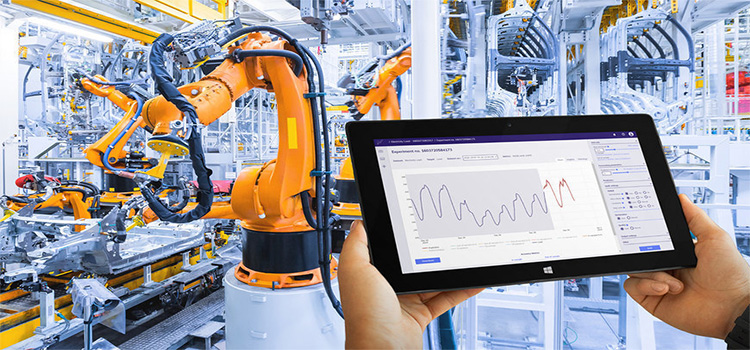
Warehouse Collaborative Robot Market by Component (Hardware and Software), by Payload ( Up to 5 Kg, Between 5Kg- 10 Kg, and More than 10 Kg), by Application (Handling, Placing, Dispensing, Assembling, Processing, Transportation and Others), and by End-User (E-commerce, Logistics and Distribution, Automotive, Electrical & Electronics, Chemicals, Rubbers & Plastics, Metal & Machinery, Food & Beverages, Pharmaceuticals & Cosmetics, and Others)– Global Opportunity Analysis and Industry Forecast 2024-2030
Warehouse Collaborative Robot Market Overview
The global Warehouse Collaborative Robot market size was valued at USD 396 million in 2023 and is predicted to reach USD 991 million by 2030 with a CAGR of 13.3% from 2024-2030.
The warehouse collaborative robots market refers to the segment of the robotics industry focused on the development and deployment of robots designed to work alongside human workers in warehouse settings. These robots, often called "cobots" (collaborative robots), are engineered to enhance efficiency, accuracy, and safety in various warehouse operations such as sorting, picking, packing, and transporting goods. These robots are equipped with artificial intelligence (AI), machine learning, and advanced sensor systems to navigate warehouse environments and perform tasks with high precision. They are scalable, flexible, and can be easily integrated into existing systems, offering significant cost savings while also enhancing human-robot collaboration.
Market Dynamics and Trends
The rising adoption of automation in the increasing global e-commerce sector drives the demand for warehouse collaborative robots, as these robots are vital for handling high order volumes and ensuring operational efficiency through tasks such as picking, packing, sorting, and transporting goods. International Trade Administration states that, the size of B2B e-commerce industry reached USD 24.5 trillion while the B2C e-commerce industry size reached USD 3.46 trillion in 2023. With such rise in the e-commerce sector, there is a growing need for automation solutions for improving warehouse operations to meet the growing demands of online retail fulfilment.
Moreover, technological advancement in automation and robotics is further boosting the warehouse collaborative robot market growth, as integration of AI and machine learning are increasing the operational efficiency of cobots, making them more adaptable at warehouse environments. For instance, in November 2022, Teachman Robot launched TM AI Cobot series incorporated with AI-vision technology. Through this launch, the company aims to enhance diverse tasks such as picking & placing, palletizing, and automated optical inspection in warehouse.
Furthermore, government initiatives and support are significantly accelerating the growth of the market by providing financial incentives such as grants, subsidies, and tax breaks, to promote the integration of advanced robotics into various industries. For instance, the government of Germany announced to invest USD 420 million while the UK government plans to provide a funding of about USD 7 million to registered companies for the adoption of robotics and automation. These initiatives are aimed at helping businesses improve productivity, address labor shortages, and transition towards more efficient and automated operations, thereby driving the overall growth of the market.
However, the high initial cost associated with acquiring and implementing collaborative robot systems restrains the warehouse collaborative robot market expansion.
On the contrary, the introduction of modern technologies such as artificial intelligence (AI), machine learning, human robot interaction (HRI) technology creates ample growth opportunities for the warehouse collaborative robot market in the coming years. These technologies enable collaborative robots to operate autonomously, utilizing speech recognition and 3D imaging technology, to navigate in complex environment without human intervention.
Market Segmentations and Scope of the Study
The warehouse collaborative robot market report is segmented on the basis of component, payload, application, end-user and region. On the basis of component, the market is divided into, hardware and software. Based on payload the market is segmented into up to 5 kg, between 5kg- 10 kg, and more than 10 kg. Based on application, the market is divided into handling, placing, dispensing, assembling, processing, transportation, and others. Based on end-user, the market is segmented into e-commerce, logistics and distribution, automotive, electrical & electronics, chemicals, rubbers & plastics, metal & machinery, food & beverages, pharmaceuticals & cosmetics, and others. Regional breakdown and analysis of each of the aforesaid segments includes regions comprising of North America, Europe, Asia-Pacific, and Rest of The World (Row).
Geographical Analysis
Asia-Pacific dominates the warehouse collaborative robot market share during the forecast period due to the presence of major key players such as Beijing Geekplus Technology Co., Ltd. Quicktron Intelligent Technology Co., Ltd., and Yaskawa Electric Corporation. These companies are adopting various strategies for growth of the market in this region. For instance, in August 2022, Yaskawa Electric Corporation launched human collaboration robot series, MOTOMAN-HC30PL. The product is designed to handle tasks such as palletizing cardboard materials and providing dynamic solutions that meet the evolving needs of industrial automation.
Moreover, the expansion of e-commerce sector in this region is further driving the demand for warehouse collaborative robot. According to recent report published by International Trade Administration, China is the largest e-commerce market globally, with the industry size anticipated to reach USD 3.56 trillion by 2024. Such surge in the sectors boosts the demand for warehouse collaborative robots revolutionizing warehouse operations and propelling industrial automation.
On the other hand, North America is expected to show a steady growth in the warehouse collaborative robot market demand, due to the expansion of pharmaceutical sector in this region. These robots are utilized to excel in delicate pharmaceutical tasks such as handling hazardous materials, sorting, packaging, and labelling, ensuring precise quality control and minimizing contamination. As per latest report published by the European Federation of Pharmaceutical Industries and Associations, North America represented 49.1% of the worldwide pharmaceutical sales in 2022. Such growth in the pharmaceutical sector drives the demand for advanced automation solution to meet the specific warehouse tasks.
Moreover, the rising adoption of automation to increase the operational efficiency within the automotive warehouse, is creating the demand for warehouse collaborative robot, as these are increasingly used in the warehouses to handle tasks such as parts assembly, material handling and quality inspection. As per the report published by the International Federation of Robotics, the U.S. adopts a substantial number of robots within its automotive sector, with a total of 1,457 robots operating in the automotive industry in 2023.
Competitive Landscape
Various key players operating in the warehouse collaborative robot industry includes Universal Robots, ABB Ltd., TechMan Robot Inc., Fanuc Corp., Rethink Robotics GmbH, AUBO Robotics USA, Kawasaki Heavy Industries Ltd., Precise Automation Inc., Siasun Robot & Automation Co. Ltd., Staubli International AG and others. These market players are adopting various strategies such as collaboration and product launches to remain dominant in the market.
For instance, in December 2023, Fanuc Corp. launched its first lightweight cobot, the CRX-10iA. The product weighs only 39kg, facilitates effortless installation in diverse applications such as driverless transport systems and AGVs. The cobot features two standard-arm and long-arm versions, offering reach of 1,200mm and 1,400mm respectively, with a maximum payload of 10kg for each variant.
Moreover, in November 2023, Universal Robots launched 30 Kg collaborative robot suitable for numerous industrial operations. This robot excels in handling heavier loads with ease, catering to tasks demanding strength and accuracy and enabling seamless integration with existing automation systems and Industry 4.0 platforms.
Key Benefits
-
The report provides quantitative analysis and estimations of the warehouse collaborative robot market from 2024 to 2030, which assists in identifying the prevailing market opportunities.
-
The study comprises a deep-dive analysis of the current and future warehouse collaborative robot market trends to depict prevalent investment pockets in the market.
-
Information related to key drivers, restraints, and opportunities and their impact on the market is provided in the report.
-
Competitive analysis of the players, along with their market share is provided in the report.
-
SWOT analysis and Porters Five Forces model is elaborated in the study.
-
Value chain analysis in the market study provides a clear picture of roles of stakeholders.
Warehouse Collaborative Robot Market Key Segments
By Component
-
Hardware
-
Software
By Payload
-
Up to 5 Kg
-
Between 5kg to 10 Kg
-
More Than 10 Kg
By Application
-
Handling
-
Placing
-
Dispensing
-
Assembling
-
Processing
-
Transportation
-
Others
By End-User
-
E-commerce
-
Logistics and Distribution
-
Automotive
-
Electrical & Electronics
-
Chemicals
-
Rubbers & Plastics
-
Metal & Machinery
-
Food & Beverages
-
Pharmaceuticals & Cosmetics
-
Others
By Region
-
North America
-
The U.S.
-
Canada
-
Mexico
-
-
Europe
-
The U.K.
-
Germany
-
France
-
Italy
-
Spain
-
Denmark
-
Netherlands
-
Finland
-
Sweden
-
Norway
-
Russia
-
Rest of Europe
-
-
Asia-Pacific
-
China
-
Japan
-
India
-
South Korea
-
Australia
-
Indonesia
-
Singapore
-
Taiwan
-
Thailand
-
Rest of Asia-Pacific
-
-
Rest of the World (RoW)
-
Latin America
-
Middle East
-
Africa
-
Key Players
-
Universal Robots
-
ABB Ltd.
-
TechMan Robot Inc.
-
Fanuc Corp.
-
Rethink Robotics GmbH
-
AUBO Robotics USA
-
Kawasaki Heavy Industries Ltd.
-
Precise Automation Inc.
-
Siasun Robot & Automation Co. Ltd.
-
Staubli International AG
REPORT SCOPE AND SEGMENTATION:
|
Parameters |
Details |
|
Market Size in 2023 |
USD 396 Million |
|
Revenue Forecast in 2030 |
USD 991 Million |
|
Growth Rate |
CAGR of 13.3% 2024 to 2030 |
|
Analysis Period |
2023–2030 |
|
Base Year Considered |
2023 |
|
Forecast Period |
2024–2030 |
|
Market Size Estimation |
Billion (USD) |
|
Growth Factors |
|
|
Countries Covered |
28 |
|
Companies Profiled |
10 |
|
Market Share |
Available for 10 companies |
|
Customization Scope |
Free customization (equivalent to up to 80 working hours of analysts) after purchase. Addition or alteration to country, regional, and segment scope. |
|
Pricing and Purchase Options |
Avail customized purchase options to meet your exact research needs. |




 Speak to Our Analyst
Speak to Our Analyst


































